Doro Wat (Spicy Ethiopian Chicken Stew)
This post may contain affiliate links. See my disclosure policy.
There is a reason why Doro Wat is the national dish of Ethiopia and one of the most famous of all African dishes – it’s fabulous! This authentic Doro Wat recipe captures the very best of Ethiopian cooking!
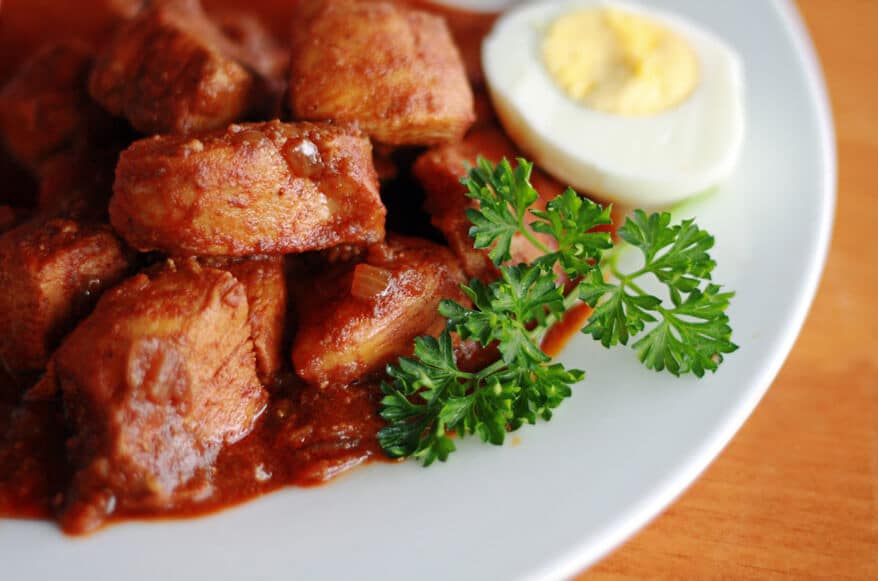
Doro Wat is one of the most famous of all African dishes. You will find it in every Ethiopian restaurant and virtually anyone who is familiar with African cuisine will have heard of it. Another version, though not as commonly known here, is Sega Wat, made with beef (fyi, you’ll find recipes online calling it Sik Sik Wat, but I’ve confirmed with the chefs of several Ethiopian restaurants that it’s Sega Wat). You can directly substitute beef for chicken and follow the same cooking instructions.
Doro Wat is traditionally made very spicy. Super spicy. Like I-don’t-know-how-Ethiopians-have-any-taste-buds-left spicy. Western adaptations are still spicy, but quite tame compared to the real deal.
This recipe for Doro Wat comes by way of request from Jared (Make a Request!). He said he has been trying for several years to find a good recipe. Jared, this recipe is both authentic and delicious – I think you’ll be very happy with it!
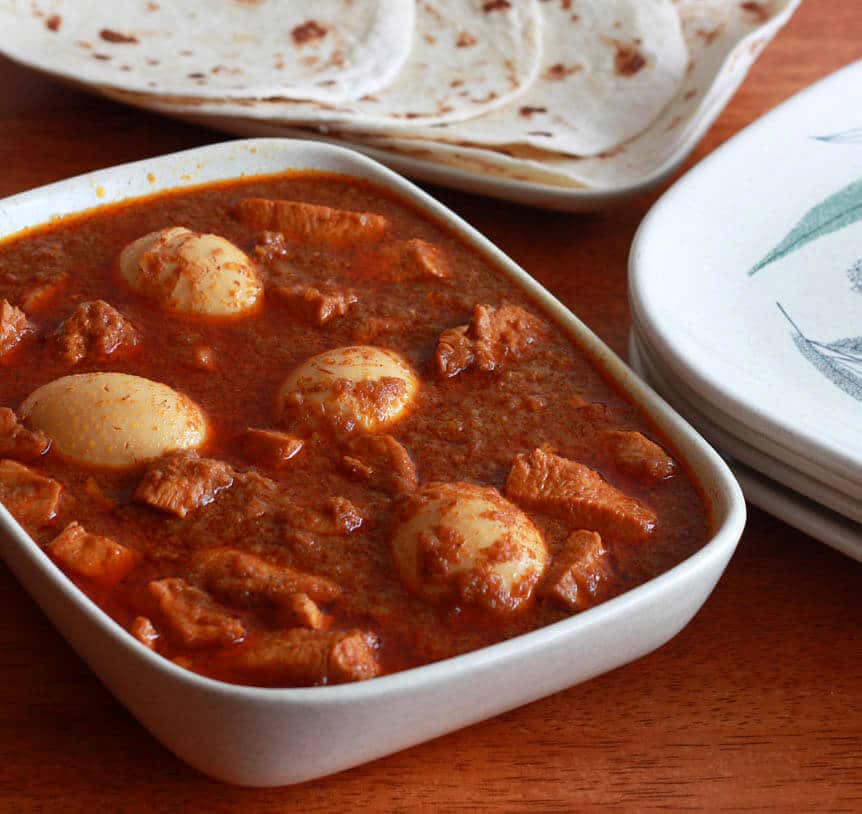
Traditionally Doro Wat is served with an Ethiopian flatbread called injera. It’s kind of a spongy pancake made with teff flour (a grain indigenous to the area), and the batter is left to ferment for up to 4 days before its used. The injera is used in place of an eating utensil and is used to scoop up the chicken stew.
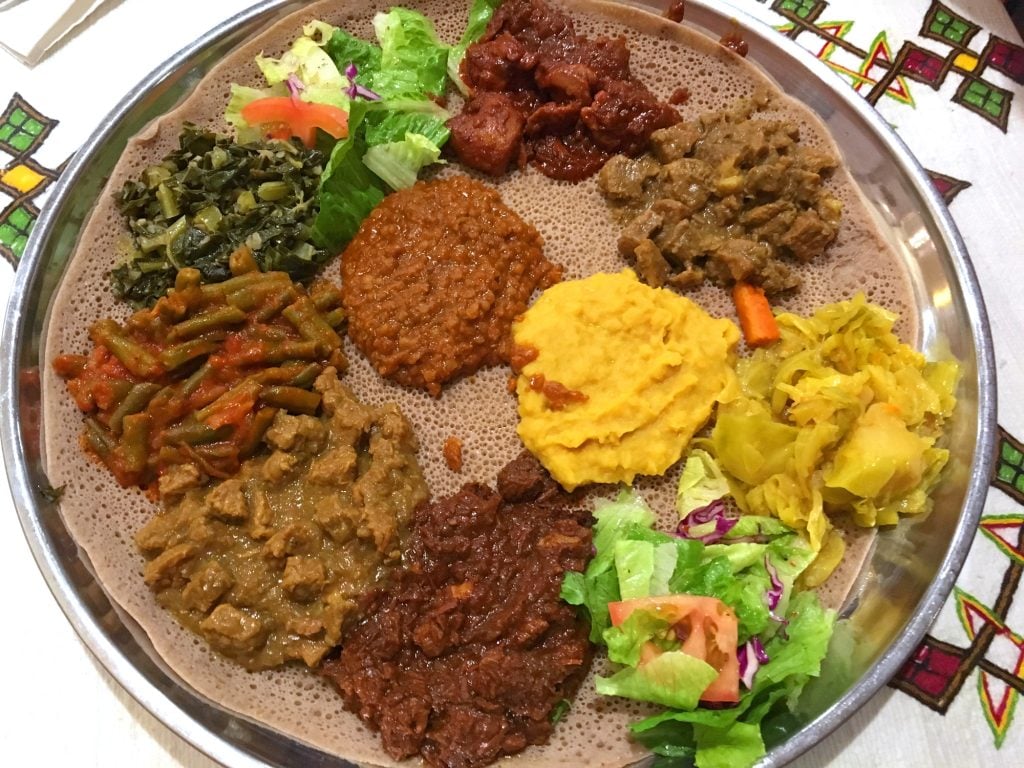
Doro Wat Key Ingredients
The key to authentic, great-tasting Doro Wat is good quality, flavorful berbere, and a very long cooking process. It can take several hours for an Ethiopian to make Doro Wat. You can cut back on the cooking time and your Doro Wat will still taste good, but it won’t taste like it’s supposed to. The magic is in the slow-cooked onions. And it takes time for the magic to happen.
A central ingredient of Doro Wat is Berbere, a fiery, bright red and flavorful Ethiopian spice blend. It is best made fresh using whole spices that are toasted and ground for maximum flavor. A combination of whole and ground spices are used as seen in the picture below.

The whole spices are toasted and ground up with the already ground spices to make a beautiful, aromatic, flavorful and spicy seasoning blend.
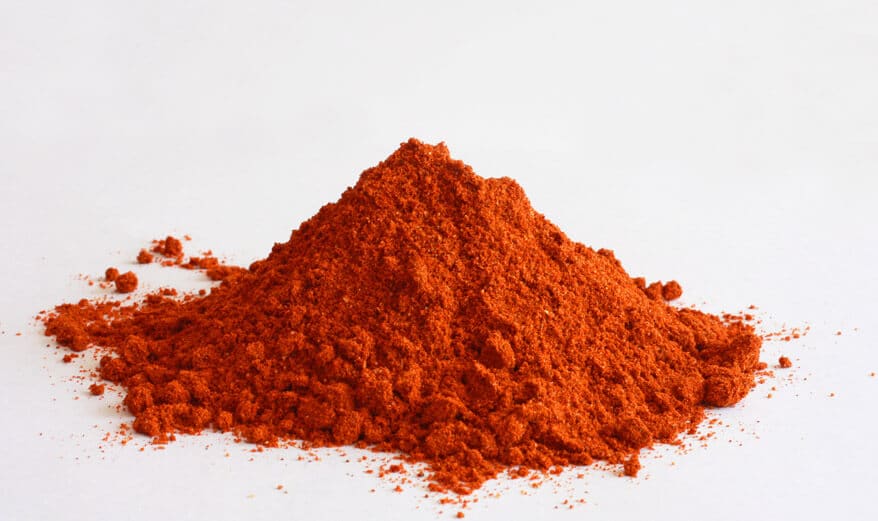
Purchasing these spices will serve you well as each of them are commonly used in a large variety of other cuisines. Stored in airtight glass jars in a dark place, they will keep a very long time. If you’d rather purchase berbere, you can find it online. You need 1/4-1/3 cup for this recipe alone, so forget the tiny 2-3 oz jars of it you usually find for sale. The best deal I’ve found for bulk berbere (and it also happens to be organic and a reputable brand) can be found HERE.
Berbere makes a great rub for meat, poultry, and fish, as well as a seasoning for stews, soups, and vegetables. It’s a great all-purpose spice, so you’ll be able to make good use of this bulk package if you decide to buy versus make your own.
Another key ingredient in Doro Wat and Ethiopian cooking at large is niter kibbeh, a seasoned clarified butter. You can find it in Indian grocery stores and well-stocked Asian markets, but as always I strongly recommend making your own for the best flavor. Check out my recipe for homemade Niter Kibbeh!

Doro Wat Recipe
Let’s get started!
Use a food processor to very finely mince the onion – you want an almost chunky puree.
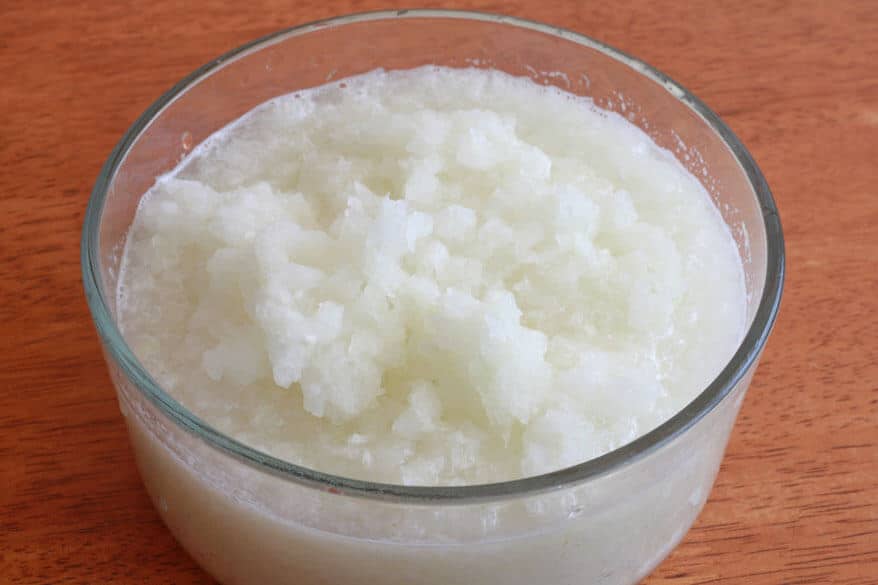
Heat 2 tablespoons of oil and 2 tablespoons of niter kibbeh in a Dutch oven and saute the onion, covered, over low heat for 45 minutes, stirring occasionally. Add more niter kibbeh if it gets too dry.
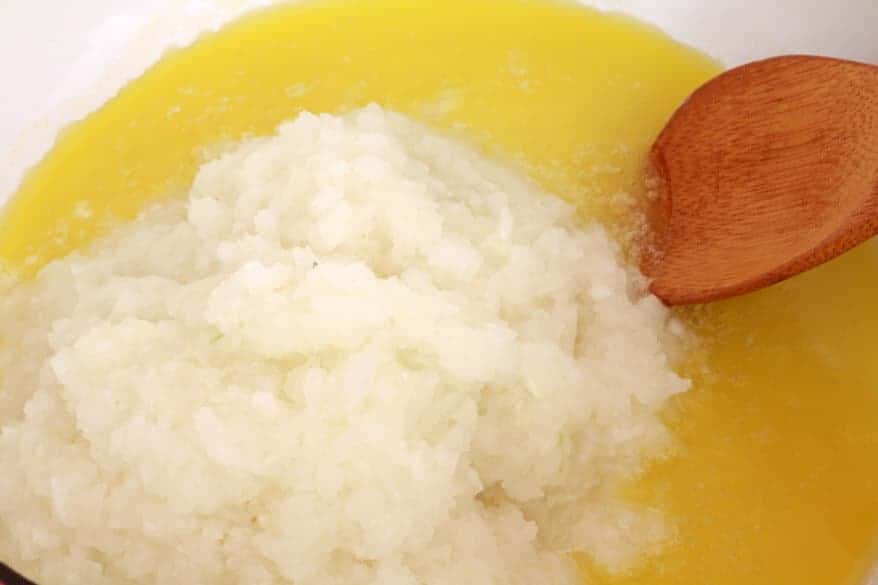
In the meantime, finely mince the garlic and ginger.
Add the garlic, ginger, and 1 tablespoon of butter. Continue to saute, covered, over low heat for another 20 minutes, stirring occasionally.
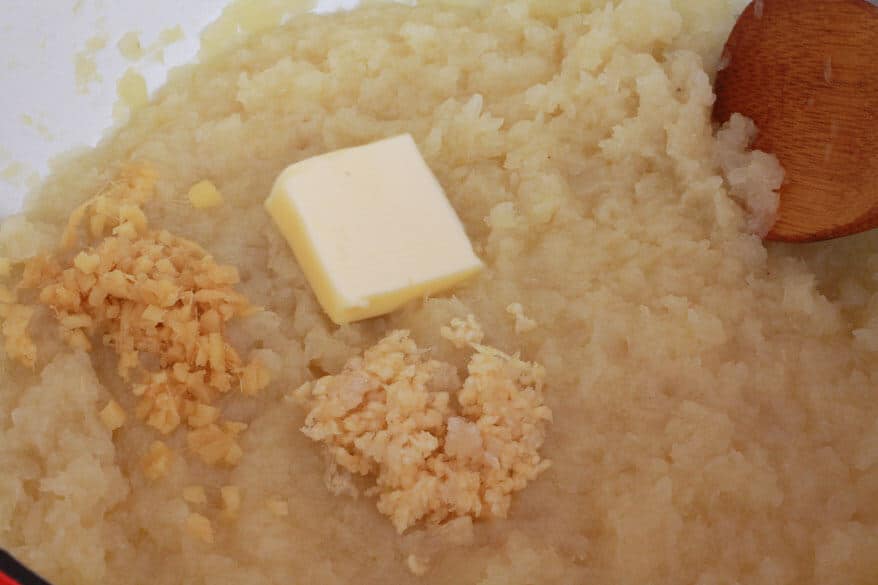
Add 4 tablespoons of berbere and 2 teaspoons salt and stir to combine.
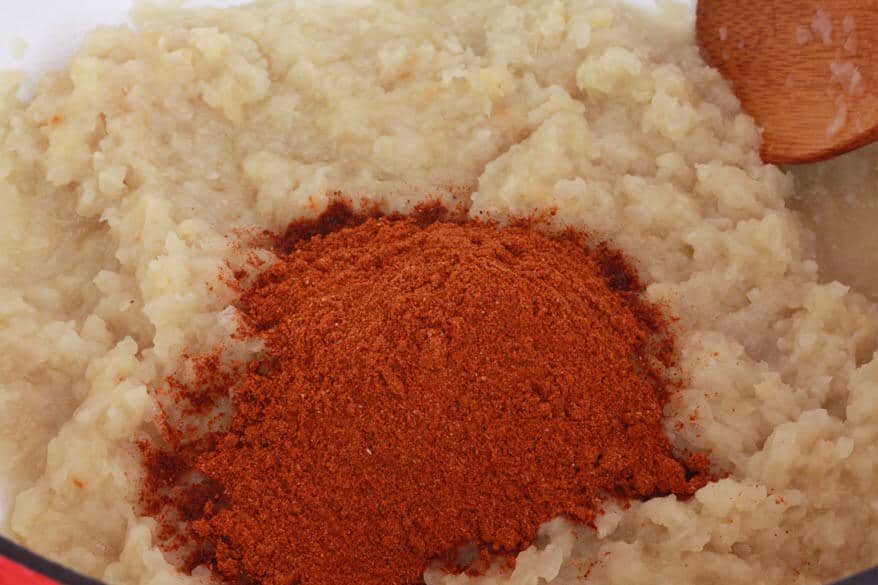
Add 2 tablespoons of butter, cover, and simmer over low heat for another 30 minutes, stirring occasionally.
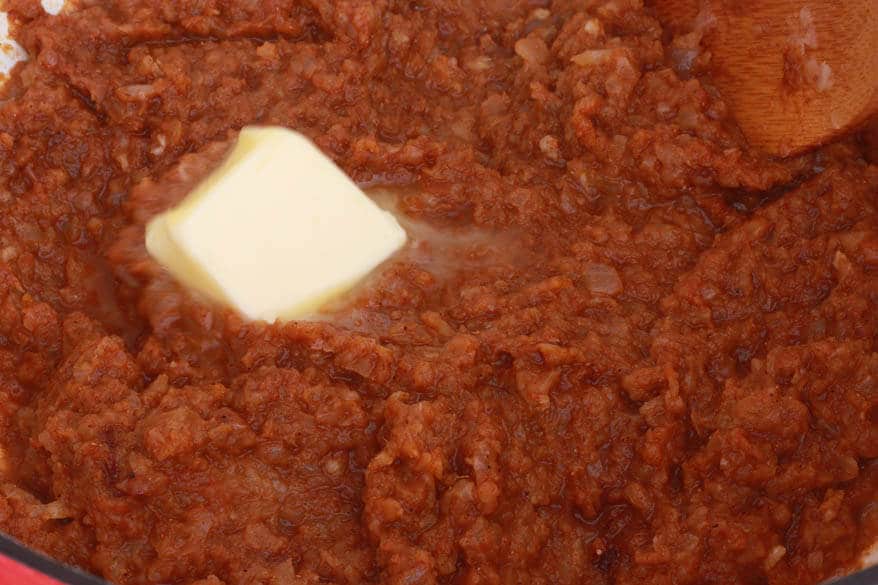
After 30 minutes you’ll have a rich and luscious sauce that’s ready for the chicken!
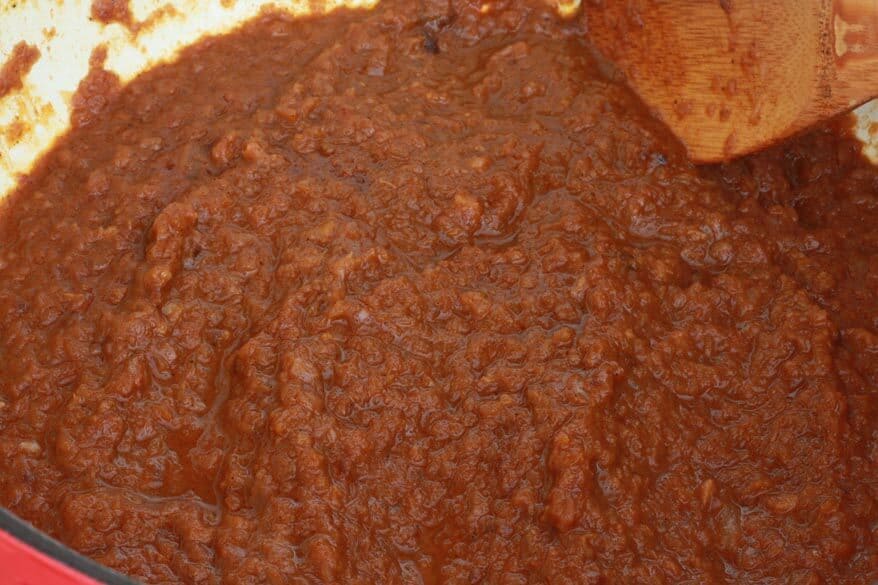
Traditionally, bone-in, skin-on chicken pieces are used. You can either use chicken thighs, cut into 1 inch chunks, or use boneless chicken breast. I used breast this time. Cut the breast into small, 1/2 inch chunks. Place the chunks in a dish with 2 tablespoons lemon juice and let sit at least 15 minutes.
Add the chicken to the sauce.
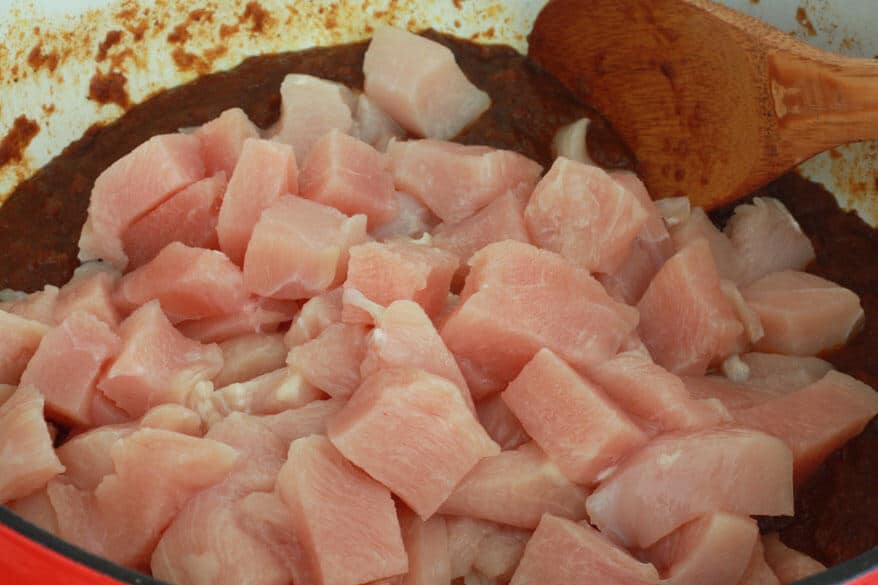
Traditionally, Tej is used, an Ethiopian honey wine. If you have access to it, use it. Alternatively you can substitute white wine with a teaspoon of honey.
Add the chicken stock, salt and honey wine to the mixture. Bring to a boil, reduce the heat to low, cover, and simmer for 45 minutes, stirring occasionally.
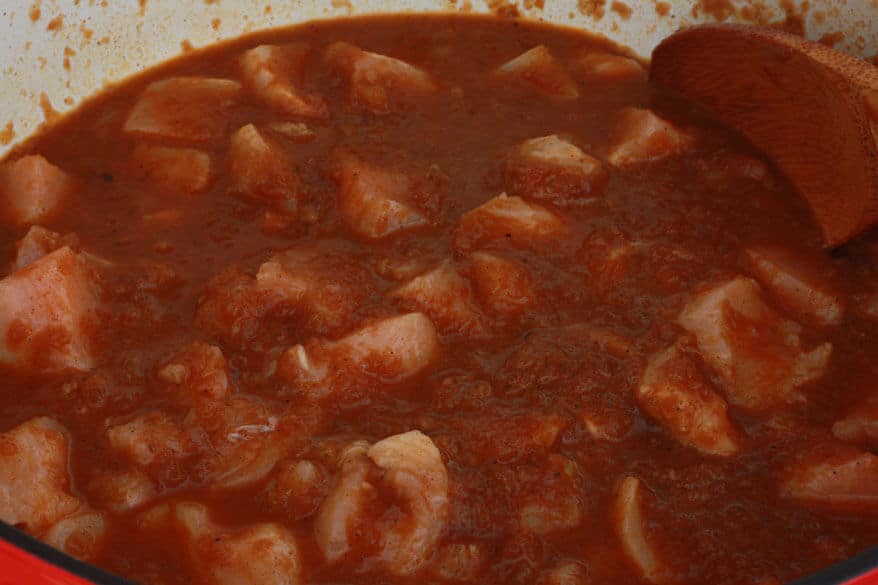
In the meantime, boil the eggs. Once the eggs have cooled enough to handle, peel and pierce them all over with a fork, about 1/4 inch deep, to allow the sauce to penetrate.
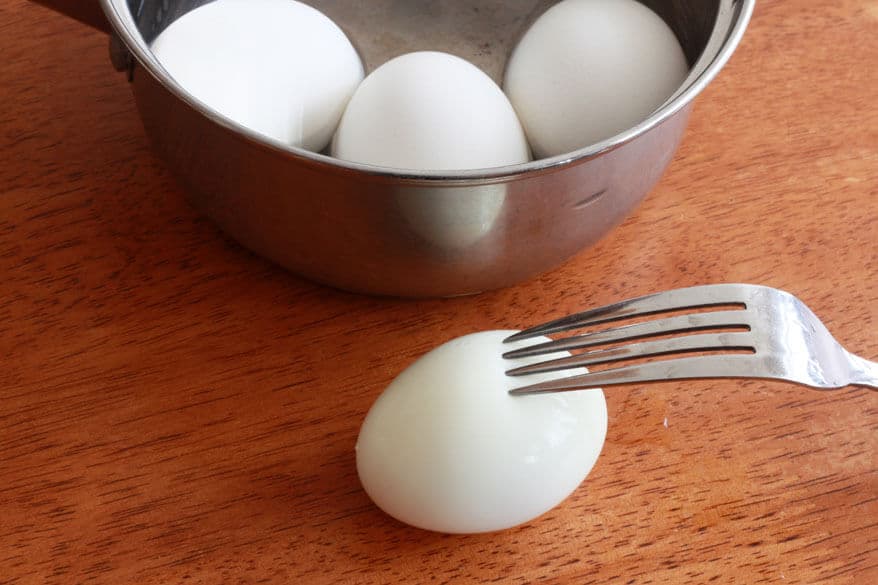
After 45 minutes you’ll have a rich, luscious spicy chicken stew ready for the eggs!
Add the eggs and continue to simmer, covered, over low heat for 15 minutes, stirring occasionally. Adjust the seasonings according to taste. Add more berbere according to heat preference.
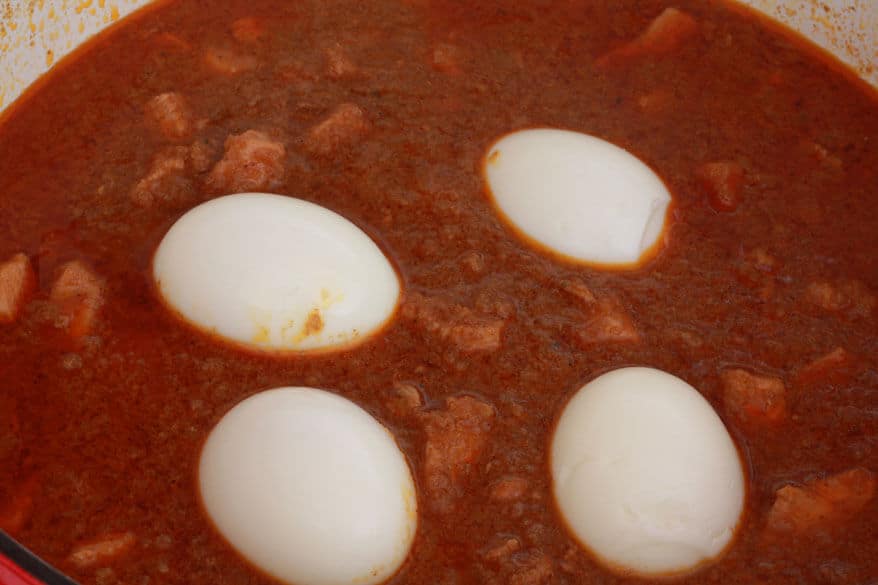

Serve with Authentic Injera (Ethiopian Flatbread).
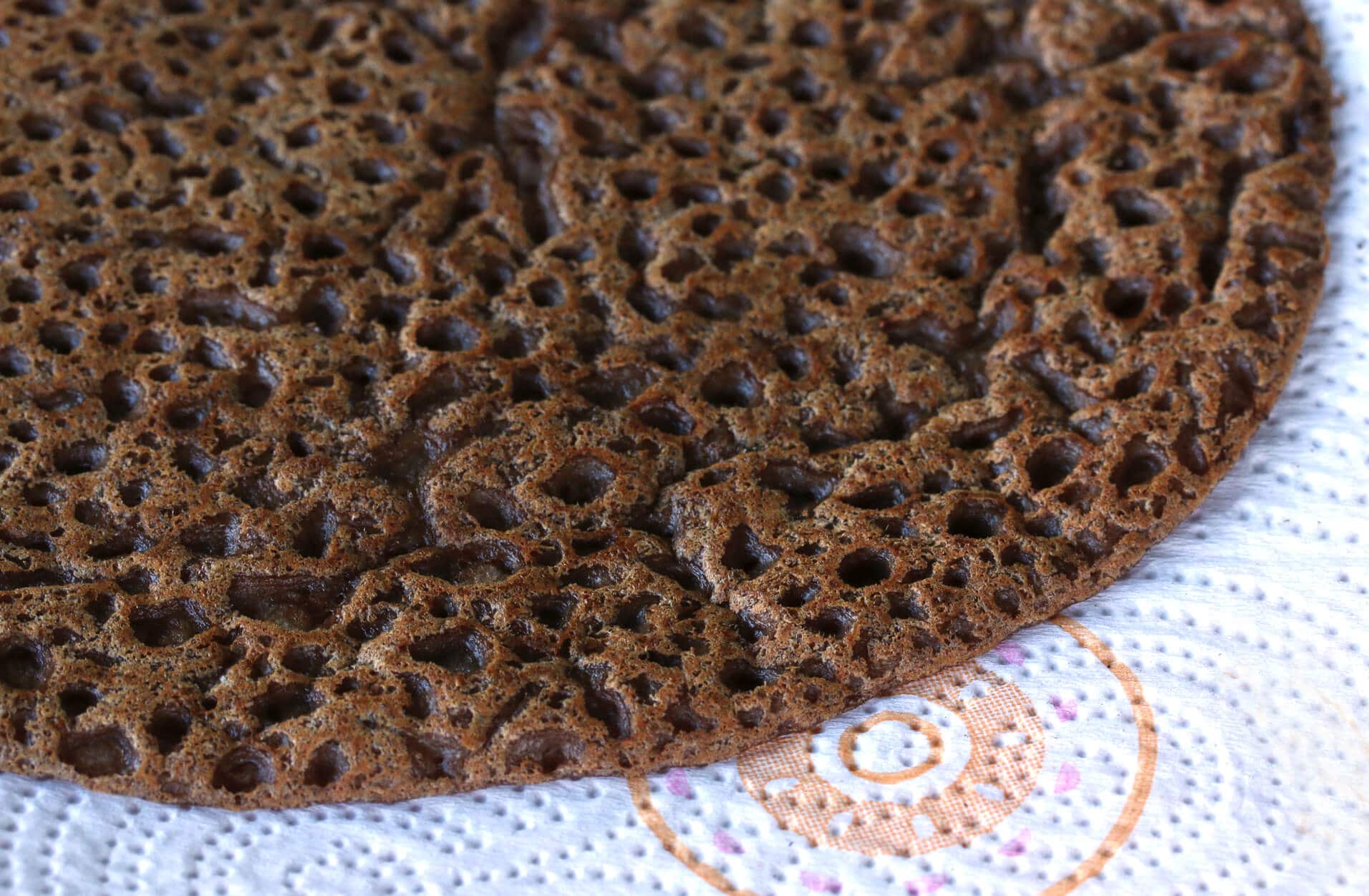
Be sure to also try our authentic Sega Wat, the famous and incredibly delicious Ethiopian spicy beef stew!
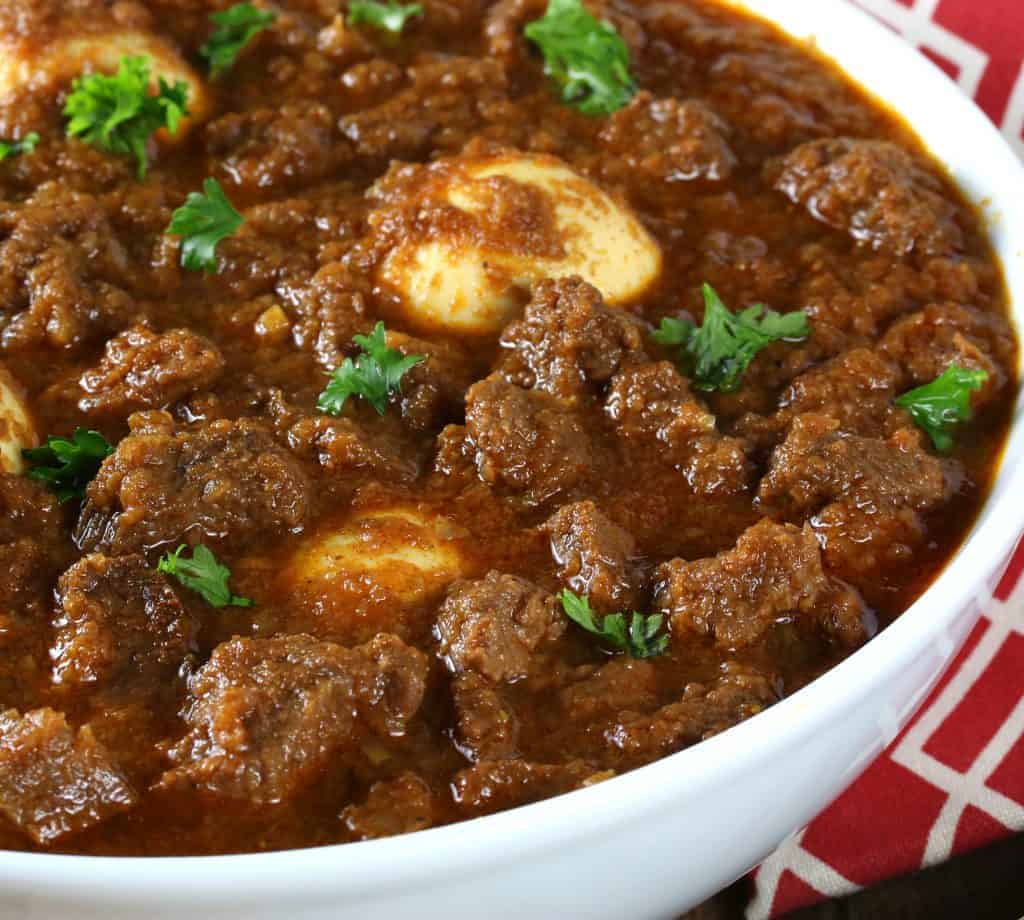
Lastly, for an authentic Ethiopian side dish to serve with your doro wat, try our Gomen (Ethiopian Collard Greens)!
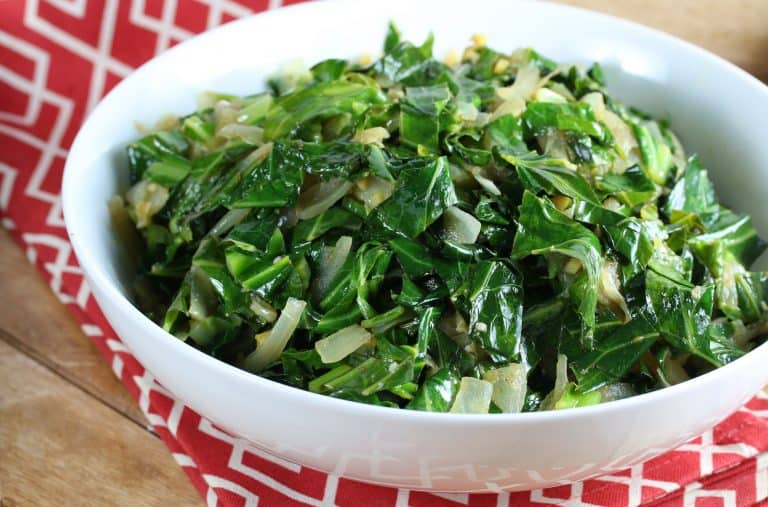
Save This Recipe
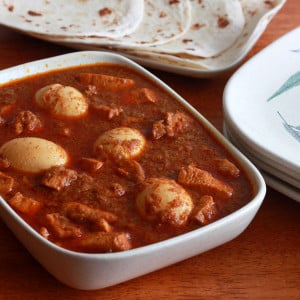
Doro Wat (Ethiopian Spiced Chicken)
Equipment
Ingredients
- 3 lbs chicken thighs , cut into 1 inch pieces, or 3 chicken breasts, cut into 1/2 inch pieces
- 2 tablespoons fresh lemon juice
- 2 tablespoons niter kibbeh
- 2 tablespoons extra virgin olive oil
- 3 cups chopped yellow onions
- 3 tablespoons butter
- 1 tablespoon finely minced garlic
- 1 tablespoon finely minced ginger
- 1/4 cup Ethiopian berbere
- or use HOMEMADE BERBERE (HIGHLY recommended!)
- 1 1/2 teaspoons salt
- 1/2 cup Tej (Ethiopian honey wine) (alternatively you can substitute white wine mixed with 1 teaspoon honey)
- 1 cup chicken stock
- 4 hard-boiled eggs , pierced all over with fork about 1/4 inch deep
Instructions
- Place the onions in a food processor and finely mince them to a chunky puree. Set aside.Place the chicken pieces in a bowl and pour lemon juice over. Let sit at room temperature for at least 30 minutes.
- Heat the niter kibbeh or butter along with the olive oil in a Dutch oven or heavy pot. Add the onions and saute, covered, over low heat for 45 minutes, stirring occasionally.Add the garlic, ginger, and 1 tablespoon butter and continue to saute, covered, for another 20 minutes, stirring occasionally. Add the berbere and the 2 remaining tablespoons of butter and saute, covered, over low heat for another 30 minutes, stirring occasionally.Add the chicken, broth, salt and wine and bring to a boil. Reduce the heat to low, cover, and simmer for 45 minutes, stirring occasionally.Adjust the seasonings, adding more berbere according to heat preference. Add the boiled eggs and simmer on low heat, covered, for another 15 minutes.
- Half or quarter the eggs and arrange on the plates with the stew. Serve hot with injera, bread or rice.
Nutrition
Originally published on The Daring Gourmet August 27, 2013



















We have a teenage boy from Eritrea living with us, and I wanted to make something from his homeland (Eritrea used to be part of Ethiopia), so I tried this dish. It was a huge hit and absolutely amazing! Thank you for sharing this recipe!
Hi Rachael, I’m so glad to hear it was a hit and thank you for the feedback!
Hello Kimberly,
As an Ethiopian it makes me proud to see you spread this beautiful, simple yet difficult to master dish. I want to add few things. As I mentioned this dish is very simple but tricky. The trick is in the onions. You don’t want too much onion or too little. As a rule of thumb 2lbs per whole chicken or if the chicken is big then 3lbs. The onions need to be slow cooked until they melt producing their own juices. Once thats achieved the berbere comes in and that needs to be cooked minimum 1.5hrs. The chicken needs to be soaked in vinegar several hours and washed with lemon and salt thoroughly so that you don’t get that poultry smell. The boiled eggs you can cut length ways three different places so the egg absorbs the flavours even more. The key to the taste is special ethiopian butter kibbeh. This butter has so much flavours infused you can skip the garlic but is not readily available so it can be ommitted. To make this delicious dish all it requires is berbere, chicken, onion, olive oil, salt, pepper, eggs and garlic and I’d say 4-6 hrs depending on patience. Simple I known I’ve yet to perfect it like my mother. Also if you leave it over night serve at room temperature it’s delicious.
But once again thank you for sharing this. My friends love it and often we go over mum’s for a feast.
Hi med, thank you for you comment and for your insights. This is indeed a special dish and I wish kibbeh were available here. When I tried calling the grocery stores here in Seattle that supposedly carry African products I learned that they had closed down. I believe there is still one or two that advertising stocking African ingredients and I still need to see if they carry kibbeh. I would love to try your mum’s version of doro wat, I’ve no doubt it’s heavenly! Best, Kimberly
I have ordered ask the spices needed to make doro wat but plan to use bone on chicken legs and perhaps bone on thighs. How many chicken legs would be needed to follow this recipe?
Legs and thighs vary so much in size, so I just simply said about 3 pounds. Happy cooking!
I made this for dinner tonight and I used my Lodge dutch oven also! The doro wat turned out great! I used chicken legs, and by time the stew was done, the meat was falling off the bone. So spicy, so good! I’m going to make this all the time now. Thank you for posting the recipe!
Thank you, Jazmine! Bone-in chicken definitely gives the most flavor by far. And great choice for cookware! :)
the hardest thing about trying to replicate dora wat is finding chicken that taste as good and wild as the Ethiopian birds, these little pigeons dress out to bantam size and are very lean and sinewy but you will eat them down to the bone they are so tasty. What we call chicken in Europe is by comparison an overblown beach ball of fowl with very little flavor at all. Also I do wonder about the olive oil. I don’t entirely doubt it having seen olive trees in the garden of the restaurant we ate in but did not see anyone using olive oil in the month I spent in Ethiopia. We ate our dora wat in Gondor in the wonderful Lodge Fasil just outside the royal enclosure. To accompany it we had Talle, a local home brew that cuts thirst like a saw and was a wonderful foil to the heat of the stew.
Thank you for your thoughts, Yvonne. I couldn’t agree with you more about the flavor of the chicken. That’s become the problem of mass-produced food in general – the flavor is compromised. And it isn’t until we’ve eaten wild meat, or tasted produce freshly grown in its original location, that we realize how what food used to taste like.
This is a fantastic recipe! It came out absolutely perfect. Its spicy and warm and budget friendly. Freezes perfectly without eggs. I also made a tofu version for my vegetarian friend. You can see a picture on our fb page:
https://www.facebook.com/permalink.php?story_fbid=315377038660865&id=177365772461993
Thank you Kimberly. Nice Ethiopia pictures!.
Thanks so much for sharing the picture, mashabn, it looks gorgeous! So happy you enjoyed it and greatly appreciate the feedback, thank you!
Dear Daring Gourmet, I have special berbere spice home made using 12 spices and herbs, specially dried, pounded, melded and finally milled from Aleto Wondo, Ethiopia. It is strong. What amount of spice do you suggest I use. Thanks Ellin
Hi Ellin, it depends on how hot it is and how much heat you like. I deliberately keep my berbere tolerable for those who want the flavor but don’t like a lot of heat, and those who are heat-happy can simply add more hot chilies to the blend. Unless your blend is unbearably hot, I’d use the same amount.
The Ethiopian cuisine Offers a wide range of Surprising dishes:
Breads such as:
injera , dabo and ambasha.
Pulse dishes such as:
Yekik alicha – yellow split peas with turmeric sauce
Azifa – mashed lentils and red onion
kik wat -red lentils in berbere sauce
Porridge such as:
Baso – sweet Barley porridge
Kincha – Spiced wheat porridge, served hot
Beverages such as:
Tila – bitter beer with an amber colore (home made)
Avish – soft drink made from fenugreek and honey
Thanks for all the info, Ori, I’ll bet these all taste wonderful!